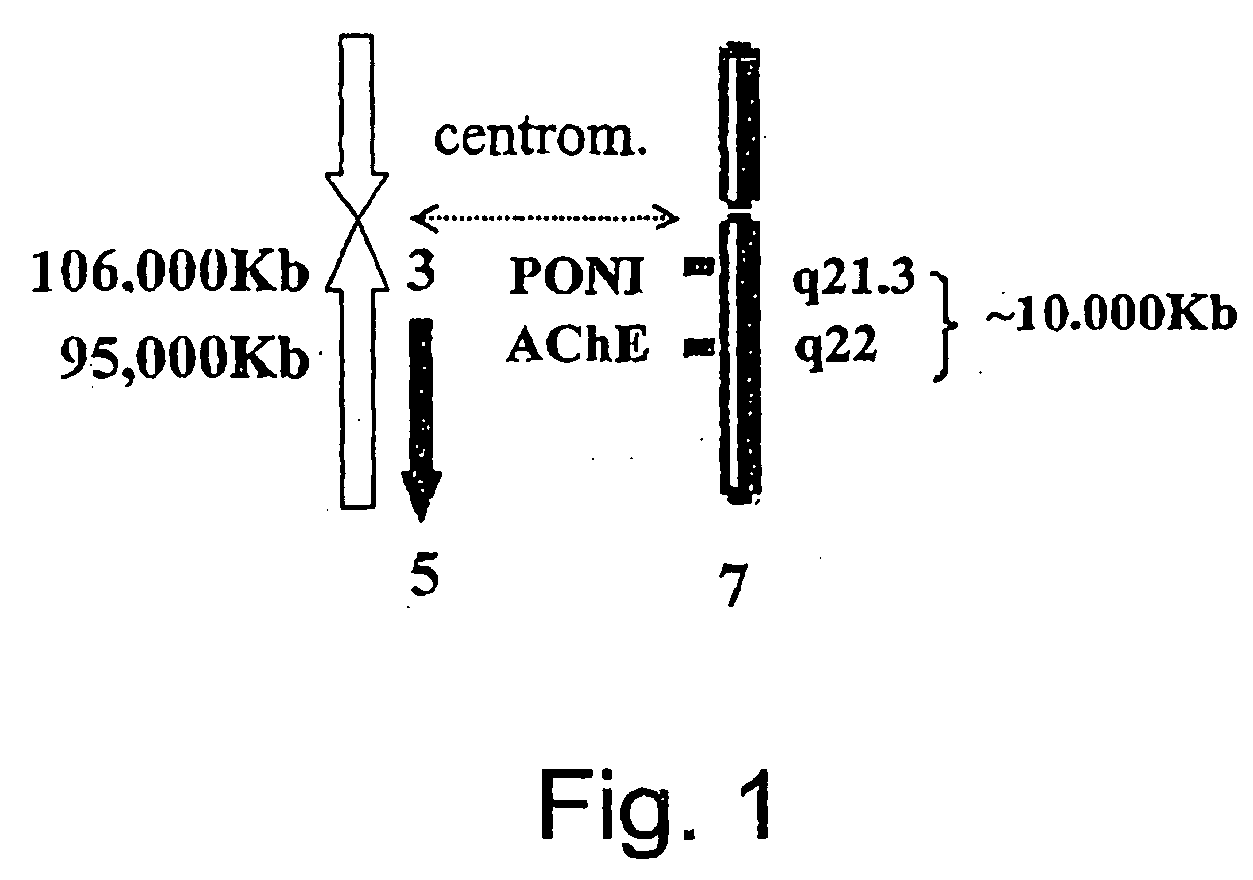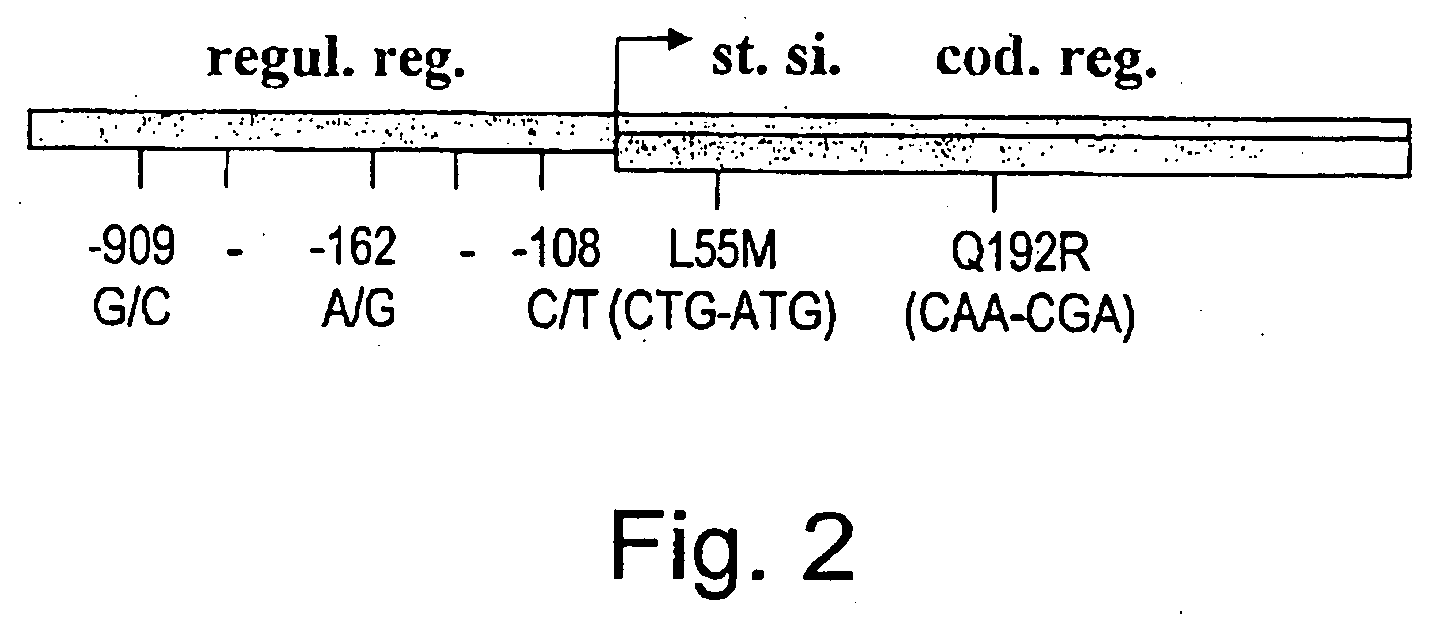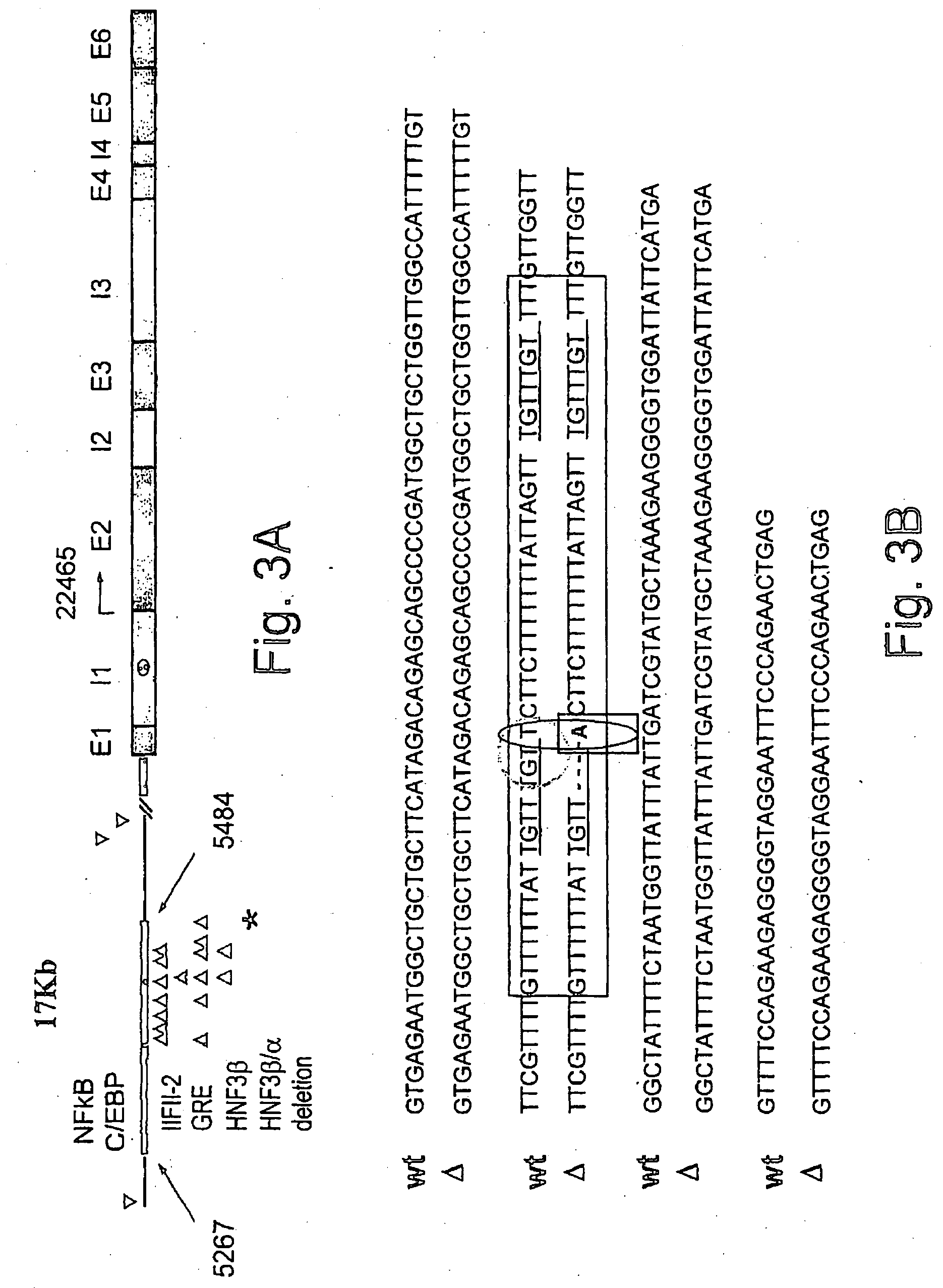Parkinson's disease susceptibility haptotype as a tool for genetic screening
a genetic screening and parkinson's disease technology, applied in the field of parkinson's disease susceptibility haptotype as a tool for genetic screening, can solve the problems of increasing the risk of parkinson's disease for relatives, increasing the risk of being afflicted, so as to achieve a lower predisposition to pd and a higher predisposition to pd
- Summary
- Abstract
- Description
- Claims
- Application Information
AI Technical Summary
Benefits of technology
Problems solved by technology
Method used
Image
Examples
example 1
A. Anamnestic Data and Clinical Parameters
[0133] The anamnestic data and clinical parameters of the subjects are summarized in Tables 3, 4, and 5.
TABLE 3PD patients living in urban area (Group 1)AgeHistoryofNo., Age, SexofPDF. H.Ethnic originA. W.onsetMedical historyPDChronic treatmentRigid.Brad.Trem. 1. 60, F, Poland−62Essential−Sinemet Gastro−−+tremor, HTN 2. 85, M, Poland+78CIHD−Dopicar Adalat+++Pergolide 3. 85, M, Poland+75CIHD, Bed ridden−Dopicar Pergolide+++ 4. 72, F, Poland+70HTN−Dopicar Sinemet+++ 5. 85, F, Germany+75—−Dopicar Norvasc−−+ 6. 88, M, Romania+72Bed ridden−Dopicar Phenergan++−dementia 7. 73, M, Hungary+63—−—+−− 8. 82, F, Romsnia+76HTN−Norvasc Simovil−−+ 9. 76, F, Poland−68NIDDM−Deralin−−+10. 77, M, Brazil+67HTN, Sick sinus−Dopicar Sinemet+++syndromeCartia11. 76, F, Egypt+77Cataract−Lipidal Gastro Vitamin D−−+12. 65, F, Brazil−62HTN, Writer cramp−Deralin Captopril+−+colorFossalanmanuf.13. 55, M, Brasil+52Meningioma−Tegretol Selegiline+++Evitol14. 68, F, Irak−6...
example 2
Frequency of “HNF-Polymorphism” on the ACHE Promoter
[0152] Over one third of PD patients suffer cholinergic deficiencies [Soreq and Zakut (1993) id ibid. J. Exposure to anti-AChEs, which causes AChE over-expression, is known to increase the risk for PD [Kaufer and Soreq (1999) id ibid.]. Therefore, the inventors explored the possibility that the HNF3 mutation, which activates ACHE gene expression, is also associated with an increased risk for PD. The results of this study indicate that this previously unforseen hypothesis seems to be true.
[0153] The incidence of ACHE promoter polymorphism was tested in several groups of Israeli individuals, healthy and unhealthy. The latter included women with pregnancy complications, and older patients following stroke or Parkinson's Disease patients (FIG. 10).
[0154] Because of the small sample size, the frequency of the mutation in some of the groups must be considered a preliminary finding. The apparently higher incidence of the ACHE promoter...
example 3
[0157] PD Screen of PON1 Alleles in Israeli Versus Other Populations
TABLE 10Healthy populationJapanRussia(Kondo et al.(Akhmedova et1998c; Suchiro etPON1 alleleIsraelal., 1999a; 2001b)al., 2000d) 55L0.610.690.94 55M0.390.310.06192Q0.70.740.381192R0.30.260.691
a[Akhmedova, S. et al. (1999) Hum Hered 49, 178-180.
b[Akhmedova et al. (2001) id ibid.]
c[Kondo et al. (1998) id ibid.]
d[Suehiro, T. et al. (2000) Atherosclerosis 150, 295-298.]
[0158]
TABLE 11PD populationJapanRussia(Kondo et al.PON1Israel(Akhmedova et1998c; Suchiro etallele(n = 39)al., 1999a; 2001b)al., 2000d) 55L0.540.57— 55M0.460.43—192Q0.690.750.278192R0.310.250.722
a[Akhmedova et al. (1999) id ibid.]
b[Akhmedova et al. (2001) id ibid.]
c[Kondo et al. (1998) id ibid.]
d[Suehiro et al. (2000) id ibid.]
[0159]
TABLE 12PD patients' genotype in the Israeli populationHNF carriersNon-carriersPON1 allele(n = 5)(n = 39) 55L0.50.54 55M0.50.46192Q0.50.69192R0.50.31
[0160] Tables 10, 11 and 12 show the results of comparisons of the genotype p...
PUM
| Property | Measurement | Unit |
|---|---|---|
| rigidity | aaaaa | aaaaa |
| plasticity | aaaaa | aaaaa |
| biochemical defect | aaaaa | aaaaa |
Abstract
Description
Claims
Application Information
 Login to View More
Login to View More - R&D
- Intellectual Property
- Life Sciences
- Materials
- Tech Scout
- Unparalleled Data Quality
- Higher Quality Content
- 60% Fewer Hallucinations
Browse by: Latest US Patents, China's latest patents, Technical Efficacy Thesaurus, Application Domain, Technology Topic, Popular Technical Reports.
© 2025 PatSnap. All rights reserved.Legal|Privacy policy|Modern Slavery Act Transparency Statement|Sitemap|About US| Contact US: help@patsnap.com



